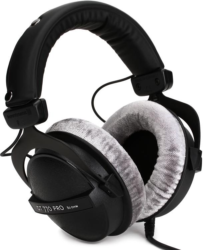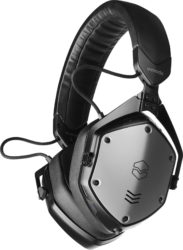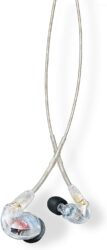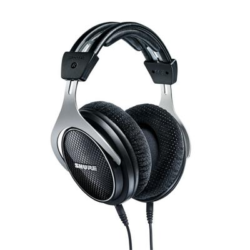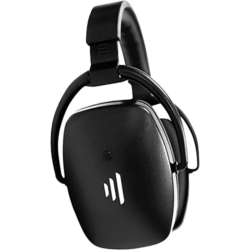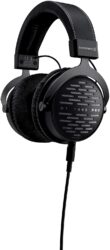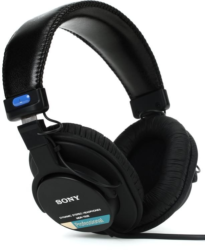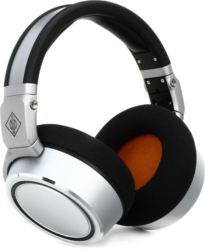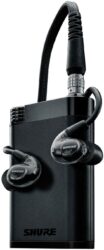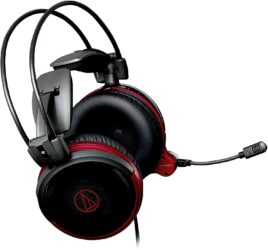Especially with more and more people working from home, enjoying solitary pastimes, and spending time online, people are increasingly investing in making their work-from-home and desktop setups more and more comfortable. Part of this often involves some kind of sound system, with many taking the step of purchasing a pair of comfortable headphones with high audio quality.
- Features to Consider in Audiophile Headphones
- Top 10 Best Audiophile Headphones 2025
- 1. Best Overall Audiophile Headphones: Beyerdynamic DT 770 Pro
- 2. Best Premium Audiophile Headphones: V-Moda M-200 ANC
- 3. Best Audiophile Earbuds: Shure SE425-CL Sound Isolating Earphones
- 4. Shure SRH1540
- 5. Most Durable Audiophile Headphones: Direct Sound True Wireless Studio Headphones
- 6. Best Open-Back Audiophile Headphones: Beyerdynamic DT 1990 Pro
- 7. Best Budget Audiophile Headphones: Sony MDR-7506
- 8. Neumann NDH20 Studio Headphone
- 9. In-Ear Headphones With the Best Audio Quality: Shure KSE1200
- 10. Best Audiophile Headphones for Gamers: Audio-Technica ATH-AG1X
- Guide to Buying the Best Audiophile Headphones for 2025
- Wrapping Up
Features to Consider in Audiophile Headphones
There’s a great reason that the audiophile community is so large and diverse: everyone has their own opinion. While this makes for great forum action, it makes for tricky shopping: there’s not necessarily a universal consensus on what headphones are the best. Most audiophiles are looking for the same general characteristics, however, all listed out below.
Audio Quality
Obviously, the first thing to consider in a pair of headphones with high audio quality is the audio quality. This is related to the specs of the drivers inside the headphones—the actual speakers that deliver the sound. Measured using statistics like impedance, sensitivity, isolation, and frequency, each headphone has its own ‘sound blend’ that makes it unique.
Noise Canceling Capability
We’ll get into more on noise canceling below, but there are a couple things you’ve got to know in advance: first, there are two types of noise canceling.
The first one, passive noise canceling, uses insulation to isolate sound. The second one, active noise canceling, uses an additional circuit with added tech to create new sounds that have the effect of canceling out the external noise. They’re both effective to various degrees depending on the design and engineering.
Wired or Wireless?
Just about 10 years ago, almost all headphones were wired, and now the world is rapidly shifting to wireless. Most wireless headphones use Bluetooth formats to transmit sounds, while many still use fixed cables to transmit.
Still other models have the option of both wired and wireless operation. It’s up to personal preference in most cases, but audio purists also pay attention to peripherals: your cable or Bluetooth software version can have an effect on sound quality.
Cable Length
Depending on what you’re doing with your headphones, consider cable length. Some headphones have removable cables that can be swapped out, others have permanently affixed cables that aren’t adjustable. If you’re planning on using them on the go, your max cable length should probably be around six feet. Using them for recording? Look for something a bit larger.
While those with wireless headphones may not have to directly consider the cable length of their headphones, they should consider their headphones’ wireless/Bluetooth range, which probably ranges between 10 and 15 feet.
Connector
Depending on what you’re using your headphones for, you’ll want a ¼-inch adapter, a 3/16-inch adapter, or even something completely wireless. Also common are 3.5 mm and ⅛ -inch versions.
There are plenty of adapters available on the market, but they can harm the audio quality and cause wear and tear on the built-in connector. If you’re using the headphones for music, you might think about a ¼-inch adapter. For computers, work, and gaming? 3/16 is the way to go. Other niche applications sometimes use other types of connectors.
Weight and Comfort
Those who are willing to pay several hundred dollars for a pair of headphones are probably frequent headphone users, listening for an entire workday or more. For these purposes, comfort and weight become increasingly important. High weights can affect neck and back comfort, and headphones with under-padded earphones cause a quite uncomfortable sensation on the ears over time.
In-Line Remote and Microphone
Depending on your needs, you might look for an in-line remote that can adjust volume, skip songs, and possibly have other programmable functions. While this tech is sometimes made obsolete by voice-control systems like Siri and Google Voice, other users find it convenient and specifically shop for something with these capabilities.
Other users might look for a microphone with their headphones. This will allow you to talk on the phone or via an online VoIP (Voice over Internet Protocol) such as Skype, Zoom, Discord, or Google Meet while using the headphones. Others who use headphones mainly for music listening or solo gaming might not necessarily need a microphone, as it will add to the cost and be a bit more fragile.
With all of that in mind, let’s take a look at our picks for the best headphones available today that even the pickiest of audiophiles will love.
Top 10 Best Audiophile Headphones 2025
1. Best Overall Audiophile Headphones: Beyerdynamic DT 770 Pro
Why we like it:
If you’re looking for something versatile, comfortable, and relatively inexpensive, these closed-back options from Beyerdynamic are well known in the audiophile world as a great set of starter headphones.
Quick Specs:
- Cable Length:9.8 feet
- Wireless:No
- Noise Canceling:Passive
- Connector:¼-inch and ⅛-inch
- Weight:0.6 lbs
- In-Line Remote and Microphone:No
If you’re just getting into the headphone world and don’t want to spend your entire paycheck on a pair of headphones, the Beyerdynamic DT 770 Pro headphones can be a great option. With sound quality good enough for professional musicians and studio use, there’s no question that they’ll work well for personal audio enjoyment as well. Listening to music and movies, they are excellent.
But in the absence of inline controls and a microphone, be advised that if you’re a gamer or have frequent online calls for work, you might be better served by something else. Consider the Direct Sound True Wireless Professional Studio Isolation Headphones for headphones with outbound audio.
While cheaper headphones sometimes have a reputation of being less durable, this closed-back model has a spring steel headband and a solid construction that yields a long working lifetime. Even better, all parts are replaceable: nothing is disposable as sometimes with other less-expensive models.
Comfort is a priority as well: the head pad is soft velour, and the ear cups are soft and plush. The package does include a soft drawstring bag that can be used as a case, which is a nice touch, although we’d frankly recommend something a bit more sturdy to protect your investment.
Pros
- Incredible comfort with great ear cups and soft velour head pad
- Spring steel headband and durable construction
- All parts are replaceable
- Sound quality is good enough for studio musicians
Cons
- Not as high-end as other audiophile-focused headphones
- We’d prefer a hard case to a soft drawstring bag
- No microphone or in-line controls
Why we like it:
If you’re an audiophile looking for a pair of headphones with active noise canceling, this relatively expensive model could be a great pick.
Quick Specs:
- Cable Length:3.9 feet
- Wireless:Yes
- Noise Canceling:Active
- Connector:⅛-inch
- Weight:0.7 lbs
- In-Line Remote and Microphone:Yes
The most characteristic feature of this pair of headphones is its active noise canceling, which is actually a bit more contentious in the audio world than you might think. Hypothetically, the ideal listening environment is completely quiet, and many audiophiles will tell you that ideally, listening should be done in a quiet space. Only a noisy environment will require the closed back and active noise-cancellation that these headphones incorporate.
Perhaps a ‘serious’ (and hyper zealous) audiophile would recommend a separate pair of earbuds for active listening (that is, listening while out and about) and another pair of earphones (probably open-backed, like this option from Audio-Technica) for quiet environments. They’re both wired and Bluetooth-equipped, although the cable includes a mic.
At the price of audio purity, there’s a benefit to this active noise-canceling tech: you can modify the sound signature of the headphones to your preference and environments using the V-MODA app that pairs to your headphones. Most important is the EQ tool that allows you to create your own sonic environment where you can even save your settings for different genres or your listening preferences.
While we like the logic behind the customization, other headphones also have this capability, just with third-party instead of native apps. Other unpopular aspects about these particular headphones: a high weight of nearly a pound, a high price tag, and a short cable: we wouldn’t use these for studio musicians.
Pros
- Phenomenal active noise canceling blocks out sound
- Customizable sound environment and technology
- Free V-MODA app allows you to manipulate EQ
- You can save settings for different genres or musical preferences
Cons
- EQ adjustment can also be accomplished with other third party apps
- Short cable isn’t great for studio musicians
- High weight and price tag
3. Best Audiophile Earbuds: Shure SE425-CL Sound Isolating Earphones
Why we like it:
If you’re an audiophile and you’re looking for a pair of unobtrusive, in-ear, earbud-style headphones, these nice but pricey ‘phones are a great option.
Quick Specs:
- Cable Length:30 feet wireless range
- Wireless:Bluetooth 5.0
- Noise Canceling:Yes
- Connector:3/16 inch (¼-inch adapter included)
- Weight:4.2 ounces
- In-Line Remote and Microphone:No
While these earphones aren’t over-the-ear headphones like most home office workers and gamers might prefer, those who are on the move will be looking for an in-ear, earbud-style headphone. Especially if you need noise reduction, you should consider this set of earbuds.
While they lack some features meant for home-office use and gaming, like a built-in in-line remote, other features ensure versatility: a ¼-inch adapter means you can use these in the studio as well as with standard 3/16-inch computer ports, there’s also a microphone for physical communication.
Meanwhile, wired/wireless combination tech allows you to have the security of a backup, battery-less pair of headphones, while the wireless mode lets you use them for exercise without the restrictions of a cable. Most shoppers, however, will probably be more preoccupied with their high audio quality than peripheral features.
Range is wide but not phenomenal, delivering deep basses at 20 hertz to 19,000 hertz of high, clear trebles. Sound is served up via two high-definition Micro Drivers, while 22 Ohms of impedance helps match the power and create a wide-feeling “soundstage,” so the listening environment feels as if you’re in a broad concert hall.
Pros
- Wired/wireless combination tech gives good backup security and portability
- Wide-feeling soundstage creates a great listening environment
- Sound delivered through micro drivers
- Sound stage feels as if you’re in a broad concert hall
Cons
- Lack features for gaming and home office use like a built-in remote
- Sometimes feels as if they focus more on peripheral features than audio quality
4. Shure SRH1540
Why we like it:
For studio musicians, DJs, engineers, or just run-of-the-mill audiophiles, these powerful noise-isolating headphones create a high-quality and crisp listening environment.
Quick Specs:
- Cable Length:6 feet
- Wireless:Wired
- Noise Canceling:Passive
- Connector:⅛-inch
- Weight:10 ounces
- In-Line Remote and Microphone:No
For serious musicians, DJs, engineers, or really anyone with a slightly higher budget, these headphones provide phenomenal performance at a bit of a price premium. Shure is an American company that’s had its ups and downs, but with this, they reach new heights: a custom-engineered driver is capable of delivering deep, throaty bass that can also be warm and soft under the right circumstances. Highs are phenomenal and piercingly clear; the product delivers an expansive feeling soundstage: great recording sounds great here, and recordings that are less-than-stellar are more evident.
Sound is delivered via powerful 40mm drivers, more than capable of overpowering the ambient noise of large events: this makes them a good pick for DJs or monitoring engineers. This is the case even though noise-canceling is all passive, coming by the way of the hemispheric ear cups as well as the sound-insulative padding contained within.
They’re comfortable but create a seal that makes you feel locked in. This can feel a bit overwhelming for some users but helps with bass.
Pros
- Sound is delivered via powerful 40mm drivers
- Hemispheric ear cups isolate sound at large, noisy events
- Phenomenal, piercingly clear highs
- Expansive feeling soundstage
Cons
- Has no active noise-canceling technology
- Ear cups can help with bass but can make for an uncomfortable
5. Most Durable Audiophile Headphones: Direct Sound True Wireless Studio Headphones
Why we like it:
If you’re not caught up with a brand name and are looking for a more wallet-friendly but still high-quality studio headphone, these headphones from Direct Sound are a great choice.
Quick Specs:
- Cable Length:N/A
- Wireless:Bluetooth
- Noise Canceling:Passive
- Connector:N/A
- Weight:8.5 ounces
- In-Line Remote and Microphone:Yes
For amateur musicians, the right recording equipment is difficult: there’s top of the line, which always comes at a steep premium, and then starter equipment, which sometimes is decent but often wears out quickly. What you’re really looking for is workhorse equipment, something that will serve you high audio quality for years to come at a good price.
Audio quality is important, but durability and price are arguably a bit even more so. And while these headphones don’t have the crazy audio quality of high-end, ultra-expensive models like the Shure SRH1540 Premium Closed-Back Headphones, they’ll still provide crisp audio playback.
Booming basses and crystal clear treble tones come out of a 40-millimeter driver, strong enough to blast past anything ambient in a nine-mile radius: that’s to say, if you’re a fan of volume, these can be a good pick. While the drivers do produce impressive decibels, none of the volume is dedicated to active noise cancellation.
That’s inconvenient, but the closed-back and foam insulation provide relatively strong noise cancellation. If you’re using them for studio and recording purposes, they’re more than sufficient for preventing sound bleed and letting you properly hear the mix alongside your own playing.
Pros
- Great combination of audio quality, durability, and price
- Foam insulation provides strong noise cancellation
- 40-millimeter driver provides a strong source of basses and trebles
- Workhorse equipment for working musicians
Cons
- No active noise cancellation
- Not the highest audio quality in the world
6. Best Open-Back Audiophile Headphones: Beyerdynamic DT 1990 Pro
Why we like it:
These German-made headphones are designated as ‘studio reference class,’ making them not only great for mixing and mastering, but also phenomenal for enjoying high-def music by yourself.
Quick Specs:
- Cable Length:9.8 feet or 3.9 feet
- Wireless:Bluetooth
- Noise Canceling:Yes
- Connector:3.5 mm and ¼-inch
- Weight:1.5 pounds
- In-Line Remote and Microphone:No
The phrase ‘made in Germany’ evokes high-tech engineering and expensive lab testing, and these headphones hold up to that promise. But while BMWs and Mercedes are known for finicky parts and frequent mechanical breakdowns, these wired headphones are impressively durable and user-friendly. As they’re still in the price bracket of supercars, audio quality is fantastic, but durability is above average as well.
As far as cord range goes, these headphones include two coiled cables, one of a personal-use length and the other for studio purposes. They’re also equipped with the latest Bluetooth tech for wireless transmission.
At a heavy 1.5 pounds with the case, though, you certainly pay for sound quality with weight. These are some of the heaviest headphones in our lineup, and it can definitely be noticed over long-term listening sessions. Most of that is due to the 45-millimeter driver (which admittedly provides absolutely booming bass), but part of that weight, ironically, is related to comfort. The purchase includes two earpads that are both pretty heavy; the plush headband doesn’t really help either.
Lastly, though, let’s address the elephant in the room, being the necessity of an amplifier. A typical phone doesn’t have enough power to run these headphones to their full potential, meaning you’ll need to purchase a secondary device that provides auxiliary power.
Pros
- Equipped with the most up-to-date Bluetooth tech for wireless transmission
- Includes two styles of comfortable earpads
- 45-millimeter drivers spit out hefty, deep bass
- Includes two lengths of coiled cables
- Comfortable ear cups and headband
Cons
- Heavy weight makes them uncomfortable to use for long sessions
- Require a headband for maximal utility
- Quite expensive
7. Best Budget Audiophile Headphones: Sony MDR-7506
Why we like it:
These headphones have one clear advantage over other audiophile-oriented products on the market: an incredibly accessible price tag.
Quick Specs:
- Cable Length:9.8 feet
- Wireless:No
- Noise Canceling:Passive noise canceling
- Connector:¼-inch, ⅛-inch
- Weight:.5 lbs
- In-Line Remote and Microphone:No
Sometimes, an audiophile is born with slightly less economic capacity, and in these cases, Sony has a $100-ish product to fill the niche. While they’re obviously a little simple than their German-engineered counterparts like the Beyerdynamic DT 1990 Pro Open Studio Headphones, they’re surprisingly similar in terms of both comfort and audio quality.
If we had one major complaint, it would be durability, as the plastic is more prone to breaking than with more expensive models.
Noise-canceling is quite effective, all coming from passive technology including thick ear cups and a closed-back design. This makes them great for studio sessions where the actual audio mix is more important than what you might be hearing in the real world; those same characteristics lend them to be great for producers and engineers as well.
The 9.8-foot cord can feel a bit excessive for personal use, but it’s nice to have that extra length, especially when recording. It’s also designed with a spiral pattern that keeps it relatively neat when not extending, increasing ease of use.
Pros
- Effective passive noise-canceling technology
- Thick ear cups and closed-back design
- Great for studio sessions, producers, and engineers
- Spiral pattern chord helps keep the headphones organized
Cons
- 9.8-foot cord is a bit much for personal use
- Durability is sub-par compared to more expensive models
8. Neumann NDH20 Studio Headphone
Why we like it:
These closed-back headphones provide great noise isolation, comfort, and stereo space, making them good for studio sessions.
Quick Specs:
- Cable Length:10 feet (coiled)
- Wireless:No
- Noise Canceling:Passive
- Connector:⅛-inch and ¼-inch
- Weight:0.86 lbs
- In-Line Remote and Microphone:No
If you’re a musician looking for something perfect for recording, mixing, and mastering, and you’re not afraid to shell out a bit of coin for the privilege, consider the Neumann NDH 20 for the job. These headphones, while expensive, are built for musicians looking for incredible resolution, a good idea of stereo space, and good noise isolation.
While the closed back yields a slightly lower audio quality than open-backed options like the Audio-Technica ATH-AG1X Closed Back High-Fidelity Gaming Headset, deep basses, and crystal clear high notes are still quite impressive.
On top of these technical specs, they’re also phenomenal in a non-quantifiable aspect: comfort. Featuring memory foam-equipped ear pads, they stay practical for long-term use, both for long recording monitoring sessions or mixing and mastering sit-ins, as well as over time: the memory foam is durable and won’t break down over months and years of use.
They’re also equipped with all of Neumann’s highest-end features: with proprietary studio monitors, the monster 1.5-inch drivers have a thumping bass and are powered by high-gauss neodymium magnets. All of this yields a broad depth of sound with an incredibly clear tone.
Pros
- Memory foam-equipped earbuds provide great comfort for long recording sessions
- Equipped with proprietary studio monitors
- Powered by 1.5-inch drivers and neodymium magnets
- Broad depth of sound with a soft, clear tone
Cons
- Closed-back yields lower audio quality
- Expensive price point
9. In-Ear Headphones With the Best Audio Quality: Shure KSE1200
Why we like it:
While these in-ear headphones are prohibitively expensive for most users, the truth is that they’re probably the best-sounding in-ear headphones on the market.
Quick Specs:
- Cable Length:6 feet
- Wireless:No
- Noise Canceling:Passive
- Connector:¼-inch
- Weight:1.92 lbs
- In-Line Remote and Microphone:No
These headphones are, without doubt, one of the nicest in-ear headphones out there, although they come with a serious drawback. They require an auxiliary battery pack (an amplifier) to function properly, something that’s inconvenient for many users but absolutely fundamental for premium audio tech.
Thankfully, it’s all included in the set alongside a set of adapters, chords, ear tips, and a softshell case. This all contributes to the quoted weight of almost two pounds, which sounds almost impossible but makes more sense once accessories are added in.
One thing these headphones do better than any other in-ear models is provide an ample soundstage. While many earbuds can be a bit claustrophobic, locking you in to the music experience, these earbuds let the sounds breathe similarly to the way an open-back headphone does.
At the end of the day, though, you’ve got to meet two requirements to buy these headphones: first, have a budget that permits you to buy a pair of earbuds that will run you about $2,000. Secondly, you need to want a pair of earbuds in the first place: many audiophiles prefer full, over-ear headphones over in-ear counterparts. If you fit the requirements, though, you’ll end up with a product that is nearly unbeatable when put up against competitors.
Pros
- Set includes adapters, cords, ear tips, amplifier, and a softshell case
- Provide an ample and breathable-feeling soundstage
- Nearly unbeatable against near-competitors
Cons
- Many audiophiles will prefer a pair of over-ear headphones
- Require an incredibly high budget
- While the amplifer is included, it’s still inconvenient to use
10. Best Audiophile Headphones for Gamers: Audio-Technica ATH-AG1X
Why we like it:
Audio-Technica finally gets a gaming headset right, delivering high audio quality for the category in both closed-back and open-back options.
Quick Specs:
- Cable Length:6.5 feet
- Wireless:No
- Noise Canceling:Yes
- Connector:3.5 mm
- Weight:10 ounces
- In-Line Remote and Microphone:Yes
Audiophiles and gaming headsets have never gotten along particularly well, with companies having a difficult time blending a headset microphone with good audio quality and an accessible price point. Industry staple Audio-Technica manages to crack the code here with this sub-$200 headset that manages to balance all three better than most gaming headsets we’ve seen, most importantly emphasizing audio quality.
One thing to be aware of is the pretty impressive weight, however, as both versions weigh in at just over half a pound. We think that’s pretty impressive for a full-sized gaming headphone with a microphone. The microphone, though, is admittedly not of top quality. Streamers might consider staying away.
While the product is sold as a gaming headset, they can be used for high-def audio as well: 53 millimeter drivers and a double air damping system deliver thumping bass; a broad hertz range and high impedance improve the sound stage and create clear highs.
The headphones come in closed-back and open-backed versions: while open-back headphones arguably perform slightly better, if you’re looking for noise-canceling we’d recommend the closed-back headphones. If you game and/or listen always while in quiet environments, however, the open-back model can offer slightly better audio quality.
Pros
- Great gaming headset that still delivers strong audio quality
- Impressive weight for a set of full-sized gaming headphones
- 53-millimeter drivers and air damping system deliver thumping bass
- High impedance creates a great soundstage with clear high notes
Cons
- Open-back model delivers worse noise cancellation but slightly improved audio quality
- Microphone is not of particularly high quality
Guide to Buying the Best Audiophile Headphones for 2025
Audiophiles spend hours of research and sometimes thousands of dollars to purchase a pair of headphones that’s just to their liking. But that’s not all that goes into audiophilia: you have to earn how to appreciate audio as well. Read on to learn more about exactly what goes into a good pair of headphones and exactly what you can get out of the purchase.
A Lesson in Audio Quality
Audiophiles have a unique but rewarding hobby, focusing on maximizing the audio fidelity, or overall audio quality of their headphones in an effort to create a more enjoyable and rewarding listening experience. Audio-fidelity allows users to access new parts of the listening experience: things like stereo sound, a greater understanding of a sound stage, and an appreciation of the mixing and mastering of a recording.
Because these concepts are a bit abstract for many listeners just starting off in the high-def audio world, you’ve first got to become aware of a concept to fully enjoy it. Below, we dive into your first audiophile lesson: part one discusses the concepts you need to know to understand high-quality headphones, part two discusses how you can enjoy these qualities.
Audio Concepts
To understand your headphones, you’ve got to understand why they’re better than the $15 phones you can buy at the store. Different aspects of audio quality are measured in a couple of different ways using a few different statistics, but the main ideas can be measured using the following stats.
Frequency
Hertz is the measure of a pitch of a sound: low-pitched sounds (bass sounds, for example) have low frequencies and high-pitch sounds have high frequencies. Audiophiles look for headphones with a wide range so as to experience a full range of sounds. As the human ear can hear tones from around 20 to about 20,000 hertz, look for a headphone that covers at least that range.
Impedance
Impedance, measured in Ohms, has to do with the power matching that creates a balance between input and output in a headphone’s drivers. Impedance is important for creating balanced sound, clearer basses, and most importantly, a large soundstage.
This gives the illusion of listening to music that’s been recorded in an auditorium, the experience of listening simply feels spacious. Technically speaking, higher impedance allows for bigger, more powerful drivers. Overall, high-impedance headphones simply sound better.
Sensitivity
Different listeners have different preferences for the power of a headphone when listening to music: this is one of the reasons there’s no perfect headphone for everyone. Decibel level is the main measure of sensitivity, and each user will want to pick a headphone based on the measure with respect to how powerful a headphone is.
Isolation
Isolation refers to the type of noise-cancellation tech a specific headphone incorporates in its design. There are two specific ways to accomplish this noise isolation: passive noise canceling and active noise canceling.
Passive noise-canceling headphones like the Beyerdynamic DT 770 use layers of soundproof materials to block out external noises.
Active noise-canceling devices like the V-Moda M-200 ANC Hybrid Active Noise-Canceling Headphones actively detects external sound and plays contradictory frequency to remove that sound. Most headphones use a combination of both types of tech to minimize external noise that disrupts the listening experience.
Enjoying Audio
There’s no point in shelling out for an expensive pair of headphones if you can’t tell the difference between an expensive set and a cheap set. Read on to learn about what to look for and enjoy in a rich listening experience. Also, understand that each and every listener may have their own differing tastes.
Noise Canceling
Noise-cancelling is a buzzword for headphones, with just about every manufacturer claiming that their products magically block out sound in one way or another. More important than the buzzwords on the package, though, is the technology behind the capability. Are we talking about active noise cancellation technology, or do the headphones just add a layer of foam insulation and call it a day? We’ll go through some of the most popular technologies below.
Passive Noise Cancelling
Passive noise canceling is all about using insulation to block out external sounds. By designing plastic earcups and using layers of insulation, fabric, and foam, a noise-canceling headphone can prevent most sound from arriving at the ears. Fit is important as well, as a seal against the head can block out even more sound.
Active Noise Cancelling
Headphones with active noise canceling have a separate circuit that can detect external frequencies outside of the headphones and playback a counteracting frequency that helps cancel out the unwanted sound. They typically also incorporate elements of passive noise canceling as well.
Stereo Sound
In the world, we perceive sounds in three dimensions: everything we hear is filtered through both of our ears, allowing us to locate where a sound is relative to us and how far away it is. Stereo sound is the concept of recording something in the real world and then playing it back through headphones to imitate that real-world feeling.
It’s also sometimes referred to as ‘binaural sound,’ ‘8D sound,’ and ‘3D sound.’ A good pair of headphones coupled with a stereo recording can give a grand sense of space and a three-dimensional understanding of whatever you’re listening to. This concept is also used in video games.
Mixing and Mastering
While it’s hard to enjoy good mixing and mastering on a cheap pair of headphones or plastic earbuds, good engineering can be truly appreciated once you get into more expensive, high-fidelity-oriented products. Once you begin to listen to great audio, you understand the difference between poor recording environments, expensive recording equipment. Think of it like savoring a fine whisky: it’s an acquired taste but becomes rewarding when properly savored.
Peripheral Audiophile Purchases
Buying a pair of headphones doesn’t mean you can just call it a day at that: other factors go into audio quality, specifically everything that sound comes from. Cables, jacks, inputs, and even the audio player have significant effects on sound quality. Some ultra-high-end headphones need a power pack to give electricity to the driver as a mobile device won’t provide enough juice to get the drivers working properly.
- Headphone Amps: For large headphones with big drivers, you need a separate device besides your audio player to provide power. While many users find headphones that require separate amps increasingly inconvenient for the benefit, others swear by the sound quality that powered headphones require.
- Cables: Surprisingly, cables can affect the quality of audio. If you want to invest in peripheral audio products, the first step, and perhaps most obvious one, is to not buy the cheapest product out there. Afterwards, though, marginal benefits begin to trail off. Just make sure you’re not picking out of the bottom of the barrel.
- Adapters: While adapters are pretty simple devices, they need to fit solidly to transmit good audio quality. There’s nothing more annoying than the crackling that comes when an adapter fits right, so pay a little extra for something that won’t let you down.
Price: What Are You Really Paying For?
The world of high-end headphones is dedicated to two concepts: brand name and product quality. When purchasing headphones, in some cases you’re paying more for brand name than for audio quality, essentially purchasing a designer product. In other cases, you’re paying for something that might be a little less ‘cool’ but have a larger portion of the cost dedicated to the technology it contains. We’d recommend a product with solid fundamentals over one with a well-known brand logo, although plenty of people get value out of having something that’s intentionally well known.
Products like Beats by Dre and Apple Airpods are examples of designer products, even products well-known in the audiophile world like Sennheiser can command slight premiums over similar but marginally less-known products. It’s like buying the grocery store brand over ‘real deal’ cheerios: while most of these products are solid headphones, they just might be a little more expensive than comparable models.
Apps: Getting the Best Sound Possible
While just about every single headphone on this list will sound nearly impeccable out of the box, there are a couple of ways to get everything perfectly to your liking. One of the ways you can modify sound is with an app that modifies your device’s audio through multiple adjustable EQ bands. This allows you to mess with the bass, crispen up vocals, or really experiment to your liking. They’re not for everyone, and use them conservatively, but our favorite apps are Equalizer+ HD and EQ 10.
Caring For Your Headphones
As audiophiles invest a great deal of money and research into a purchase, it’s important to take care of what you end up buying. For some buyers, a pair of headphones with fragile componentry can end up being a recurring purchase. For those who take a bit more care of their headphones, though, a good investment can pay off over time by lasting for years and years. Follow the tips below:
- Keep Them Clean: To keep fabrics and foams healthy and long-lasting, give them a wipe down every so often with a just barely damp, soft towel: glasses cleaning cloths are just perfect.
- Use a Case: There’s no greater audiophile sin than throwing a pair of headphones in your backpack without a case. Whether you prefer to pick up a soft case or a hard case, make sure you’ve got a layer of protection when transporting headphones. Hard cases are preferable.
- Keep Them Dry: The single biggest enemy of a headphone is water: moisture gets into drivers and can completely wipe out a high-end headphone without the possibility of repair. Firstly, understand the IP rating of your headphone: The last digit of the IP code (IPX4, for example) speaks to the water-resistance of your headphone. IPX5 can withstand low-pressure water spray, but look for something IPX6 and up if you really want to be
- Watch Out for the Cable: If you’re purchasing a high-end pair of headphones, odds are that the weakest link in terms of durability is the cable itself. Protect your headphones by removing the cord if possible, or if not, by wrapping the headphones semi-loose but still organized way.
Wrapping Up
Once you’re into the world of high-fidelity audio, it’s hard to get out, so strap in and enjoy the ride. People get into the hobby for many different reasons: music lovers, gamers, musicians, and more all get into high-definition listening, each one of them with their own motives. While the hobby can be expensive and even contentious at times, there’s one thing audiophiles all agree on: there’s nothing like putting on a nice pair of headphones.

